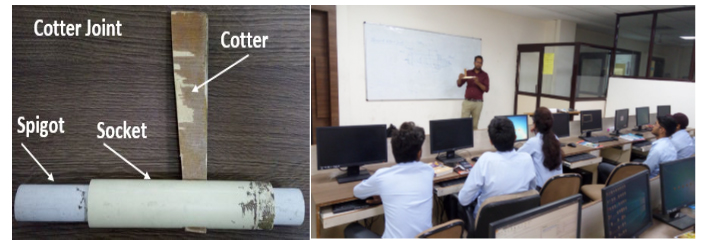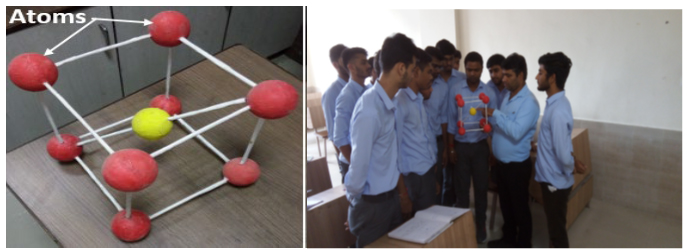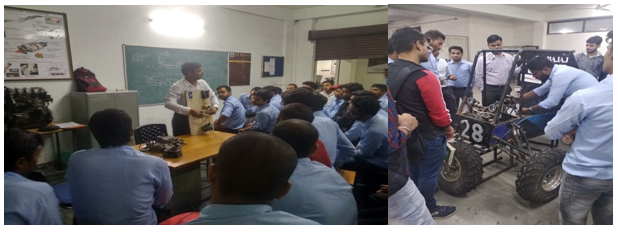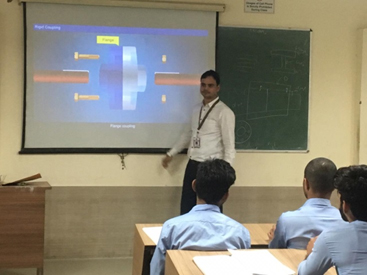Innovations by the Faculty in Teaching and Learning
Innovations in Teaching and learning refers to use of new ideas, course materials, models and ICT based tools for enhancing the learning process. Innovation in teaching differentiates b/w a Good teacher and a Great teacher [https://youtu.be/vrU6YJle6Q4 ]. The innovative practices in teaching and learning are primarily intended to stimulate the interest of the students towards the topic. These practices involves the students in the discussion, physically as well as mentally. Innovative teaching takes care of the complexity of the topic and converts them to simplified ones. Following are the some innovative tools used by the Faculty in Teaching and Learning Process:
(i) Use of 3D Models
We believe that the physical model of any product or component itself is a representation of overall concepts, idea, working, mechanism etc. which is a better tool for the classroom demonstration. It greatly helps the students to better understand the concept beside from using blackboard teaching. The faculty designs and develops the models with the help of students so as to involve them into the process. The models developed includes cotter joint, key joints in Machine Design subject, linkage mechanism for Theory of Machines. Figure 5.1 to 5.4 show the class room/lab demonstration with the help of 3D models.

Figure 5.1: 3D model of cotter joint demonstrated in Machine design-I lab
Figure 5.2: Live demo of ARISTO XT Robot manipulator 
Figure 5.3: 3D model of FCC structure demonstrated in Material Science lab 
Figure 5.4: 3D model of Fuel supply system in Automobile Engineering Lab and Live demonstration of automobile components through ATV
(ii) Use of PPTs and Video Lectures
The faculty members uses multimedia elements like LCD projectors (power point presentation, NPTEL video lectures, animated videos, cartoons etc.) in the Class room. It helps the faculties to represent the content in a more illustrative and meaningful manner. Figure 5.5 shows the use of animated video of flange coupling in classroom.

Figure 5.5: Use of animated video in class room
(iii) Video lecture prepared by In-house faculty
A video capturing facility is available in the institute to facilitate the faculty members to record their video lectures. The students can watch the recorded videos at their own convenience. Students are also motivated to follow the lectures uploaded by experts from academia on the web platforms like NPTEL. The students have shown a keen interest in these videos as an effective way of learning. The details of these lectures are available at institute website (refer undermentioned url)
https://www.glbitm.org/cpage.aspx?mpgid=141&pgidtrail=191
In order to facilitate easy access of these video lectures for the students and outside world, department has uploaded few of them on its YouTube channel Mech G.L. Bajaj. https://www.youtube.com/results?search_query=mech+gl+bajaj)
The viewers can like/dislike or suggest after going through these videos. Few screenshots of video lectures are as follows:
(iv) E & Self Learning portal
The Institute has developed an E & Self Learning portal on the Institute website for the students. Students are using the portal on regular basis for self-learning.
https://www.glbitm.org/cpage.aspx?mpgid=141&pgidtrail=199)
(v) Participatory Learning Methods (PLM)
The process of PLM involves motivation the students for participating in the classes individually, at the same time they are also advised to follow strict ethical values while participating in the discussion. For example, they have to stand and wish all the classmates and teacher succeeded by their own introduction. During PLM classes the coordinator faculty ask the students to express area of their interest (general awareness or technical awareness) and put forward two to three relevant questions. Subsequently other students express their willingness to answer the query and they are allowed to do so by following same ethical process. It is ensured by the faculty that each student of the class should speak atleast once. It was felt after analysis that more than 60% students were supporting the continuation of the classes as they felt improvement in their technical and presentation skills.
(vi) Peer to Peer Learning environment
“Each one teach one” Using peer teaching in a student’s group. Peer to Peer learning methodology helps the students to overcome hesitation and stimulates them to compete with their peers. The regular reports of low participation levels in group discussions and low confidence level in personal interview was the major reason for creating peer to peer learning program.
Two peer education groups from third year and final year were created and designated as peer educators after initial briefing and training. The peer group from final year was asked to interact with the third year students on one-to one basis. The outcome of the interaction was the technical and communicational abilities of students. An analysis of these interactions were recorded on hard copies and third year students scoring more than 50% were nominated as peer educators for their juniors. These peer educators were then instructed to conduct topic based training for second year students. The feedback of these students were conducted and analyzed to understand the impact. The willingness to conduct more such programs was measured as 4.08 on the scale of 5. The improvement in technical skills scored minimum 3 on the scale of 5.